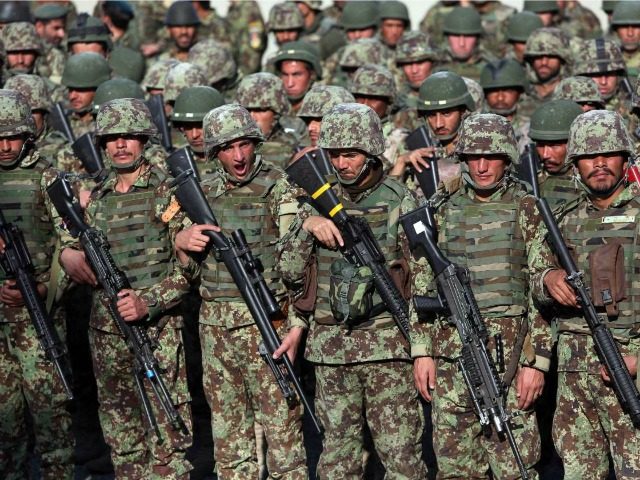Washington and Kabul are clueless as to how many Afghan security troops “actually exist,” are available for duty, and whether they are truly capable of defending their own country, a top government watchdog tells Congress.
That revelation comes as the U.S.-backed Afghan National Defense and Security Forces (ANDSF), which includes police and military units, fights to reverse deteriorating security conditions fueled by a renascent Taliban, a growing Islamic State (ISIS/ISIL) presence, a resilient al-Qaeda, and other terrorist threats.
In its latest (31st) quarterly report to Congress, the office of the Special Inspector General for Afghanistan Reconstruction (SIGAR) reports that data on ANDSF’s total manpower eludes officials in the United States and Afghanistan.
Under the section in the report titled Force Strength Numbers Are Questionable, John Sopko, the inspector general (IG), wrote:
For years, the authorized strength of the ANDSF has been 352,000 soldiers and police. The ANDSF’s reported actual strength has at times approached that goal, but never reached it. More troubling is SIGAR’s assessment that neither the United States nor its Afghan allies know how many Afghan soldiers and police actually exist, how many are in fact available for duty, or, by extension, the true nature of their operational capabilities.
For example, an infantry unit short of radio operators, mortar crews, medics, or reconnaissance scouts is not nearly as capable as one that is up to strength in those and other skill areas.
After nearly a decade-and-a-half of U.S. military training and an investment of billions of dollars in American taxpayer funds, the development of the ANDSF still “faces stern challenges,” declared Sopko.
“Progress has indeed been delayed and uneven,” he reported. “Further, SIGAR has found many instances when U.S. funding dedicated to the ANDSF was wasted, whether inefficiently spent on worthwhile endeavors or squandered on activities that delivered no apparent benefit.”
SIGAR was appointed by Congress to oversee the multi-billion-dollar U.S. nation-building effort in Afghanistan.
Nearly a year ago to the day, SIGAR sounded the alarm on numerous ANDSF personnel issues, particularly a lack of accurate and reliable data on manpower, capability, and U.S.-taxpayer funded payroll.
At the end of April 2015, Sopko warned that inaccurate and unreliable data on Afghan security personnel may place U.S. security and billions of American taxpayer funds at risk.
Since the start of the Afghanistan war in October 2001, more than 15 years ago, Congress has appropriated more than $113 billion for nation-building efforts, of which nearly 60 percent ($68 billion) has been devoted to security-related projects, including the development of the Afghan security forces.
The nearly $70 billion figure includes over $4 billion spent on funding the salaries of the ANDSF soldiers and police officers.
In February, Gen. John Campbell, then-top commander of U.S. and NATO forces in Afghanistan, stressed to a Senate panel that the Afghan security troops suffer from capability gaps, particularly in areas of aviation, weapons operations, and intelligence gathering.
“Those capability gaps notwithstanding, I still assess that at least 70 percent of the problems facing the Afghan security forces result from poor leadership,” testified Campbell.
Although the general did point out that dozens of officers had been discharged over poor performance, the lack of accurate data on Afghan security personnel and their capability remains an obstacle to the development of the ANDSF and risk to the country’s security.
A capable and effective ANDSF is essential to preventing Afghanistan from once again becoming a launching pad and safe haven for terrorist groups seeking to attack the United States and its allies.
The ANDSF assumed the lead responsibility for its own security and enforcing the rule of law in Afghanistan at the beginning of 2015.
SIGAR’s latest report to Congress, which covers the first three months of 2016, highlights the languishing security conditions in Afghanistan where civilians and security forces have suffered record casualties, primarily at the hands of the Taliban.
It includes an entire section on the “deteriorating security” in the country, which covers:
- Warnings by Gen. Campbell that 2016 may be more violent than the previous years;
- Claim that 30 percent of Afghanistan is under insurgent control or influence;
- Taliban on the brink of recapturing Helmand, largest province in Afghanistan;
- Afghan security forces to remain ineffective in foreseeable future.
SIGAR reported:
Meanwhile, challenges for security forces are multiplying. Not only did the Taliban step up attacks during the past winter — usually a relatively quiet season— but other groups expanded their presence in Afghanistan. They include al-Qaeda in the Indian Subcontinent — a relatively new offshoot of al-Qaeda that operates primarily in Afghanistan, Pakistan, and India — and the Islamic State of Iraq and the Levant-Khorasan Province.
Khorasan is an ancient name for a region that includes Afghanistan, Pakistan, parts of Iran, Indian, and other surrounding countries.

COMMENTS
Please let us know if you're having issues with commenting.